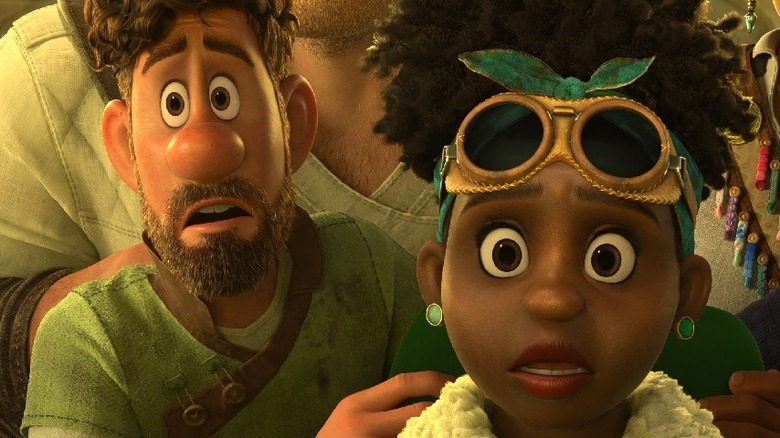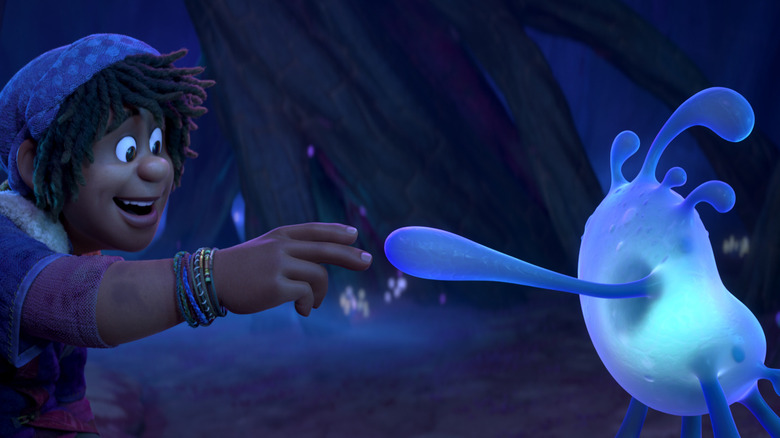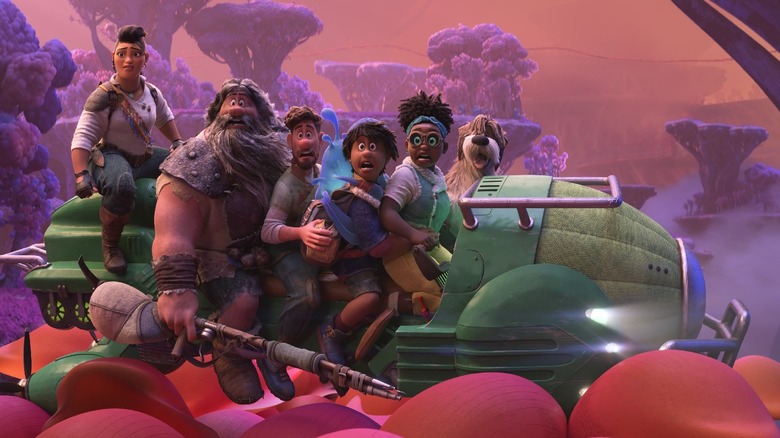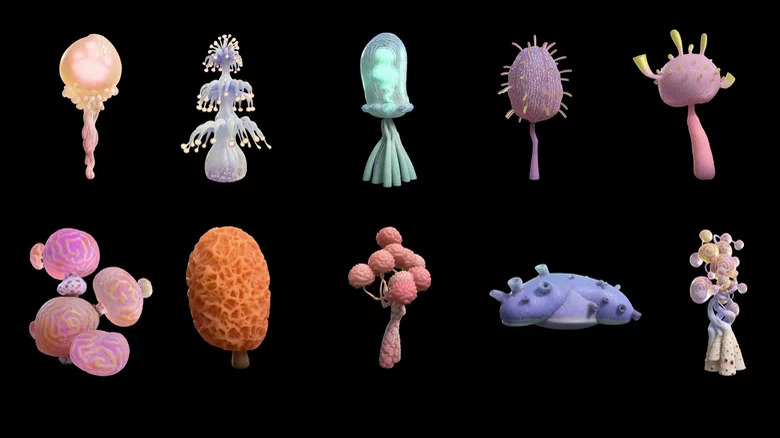Don Hall And Qui Nguyen On The Novel Journeys And Creative Ecosystems Of Strange World - Exclusive Interview
"Strange World," the latest imagination-fest from Walt Disney Animation Studios, is a wonderful story about family and finding yourself (with a keen and exciting ecological edge).
The movie follows the Clades, legendary explorers-turned-farmers-turned-explorers who explore more of their world than anyone ever has. While Jaeger Clade (Dennis Quaid) has long been absent, gone off to explore beyond the village's mountainous surroundings, his son Searcher (Jake Gyllenhaal) has stayed behind to bring power to their modernizing community. When a crisis requires Searcher to join an effort journeying into the undiscovered heart of their world, Searcher and his family have to come together to explore and survive a very ... well ... strange world.
The movie is a visual treat, with creative creatures, vivid colors, and interesting characters, all with a gorgeous pulpy aesthetic that strikes new ground for the animation pioneers at Disney. We spoke with "Strange World" director Don Hall and writer Qui Nguyen about the new animated entry, the characters' journeys, and the creation of and inspirations behind such a novel, innovative world.
Three different heroes' journeys in Strange World
This is an interesting move for Disney in taking that classic pulpy style for inspiration. Let's talk about that and how you incorporated it.
Don Hall: It was an extension of the inspirations for the film. If you look at the type of adventure story we're profiling, it's an adventure story where a group of explorers find a hidden world full of fantastic creatures and [basically] a King Kong. Knowing early on that we wanted the film to lean into that genre, we did a lot of research going all the way back to the early adventure stories of Jules Verne and Sir Arthur Conan Doyle, and those pulp adventure magazines were an extension from that.
They came a little bit later, but to me, you could draw a chart that tracks from Jules Verne all the way through those pulp adventure novels and magazines, all the way to "Raiders of the Lost Ark." It was really fun researching all that. On the cover of a lot of those magazines is a very Jaeger Clade-like character. Part of this film was taking that archetype, that adventurer character, and breaking him down a little bit and seeing some other shades [of] him.
It's so interesting, too, that in a sense, all three of the characters in that lineage — Jaeger, Searcher, and Ethan — have a different version of that archetype, where it's two poles between Jaeger and Searcher and then Ethan is kind of the modern equivalent. Can you tell me how you shaped that family lineage and their own hero's journeys?
Qui Nguyen: It was like all three characters were characters that Don and I closely related to. At the very heartbeat, we had to take these characters very personally. When you think of Jaeger, he's this ambitious person who will reach for his goals no matter what. That's [like how] Don and I wouldn't be making movies at Disney if we didn't have that same ambition in us. The same sacrifice that Jaeger had to go through, where he misses time with his family, is something we know on a very deep level [because] we're working our butts off to make these movies. Hopefully, it's worth that time and effort, because we're missing some crucial time with our families.
Searcher's definitely the ... We've been [at] points in our lives [when] we're like, "I don't want to be anything like my dad." Of course, we all end up growing up and picking up a lot of those attributes that our dads have, and we're very proud of that at this point in our lives. Then, we've all, at some point, rebelled against our parents to figure out our own pathways, which was Ethan's journey. We all personalized these characters within ourselves, which made it really fun to put on the screen.
Finding new ecological relationships
We see a wide range of the evolution of Avalonia, including different architecture designs and different invention styles from before Pando and after. Could you go into a little bit about how you arced that and how the artist worked on it?
Hall: Right at the beginning, again, [we took] inspiration from those early adventure novels. Also, [we looked] at a lot of what the science fiction of the time or fiction of the time imagined the future was going to be like. I'm talking late 1800s, early 1900s. There was this imagining of what the future will be. They had a lot of flying things. [It's] really interesting when you go back and look at magazines from that period and they're showcasing "the vehicle of tomorrow" and all that kind of stuff — really inventive, really interesting vehicles and machines.
We wanted to take inspiration from that and build a world that didn't have terrestrial cars. They had to fly in these airships, but it was all based on dirigible technology with propellers because it was fun, it was whimsical, and [it] evoke[d] the feeling from those early adventure and science fiction novels. We started there, and then knowing that we were going to show what the world was like before Pando, [we] backtracked and decided, since they didn't have any of that airship technology, it was horse, and horse and buggy, and it was a lot more pre-Industrial Revolution Europe.
The film's environmental message is not beating you over the head, but it's prominent, and it's thoughtful, and it's very resonant. The character relationships also feel very contemporary. What would you like audiences to take home from "Strange World"?
Nguyen: First and foremost, we want them to have a great time. We want this to be some people's favorite movie. We want them to go home and play pretend with these characters. But on top of that, [for] a great Disney movie ... We'd love it to cataly[ze] that conversation with families of "How are we going to be good ancestors? What are we doing today to help benefit tomorrow, to make a better future for our kids?" Come for the adventure; stay for the conversation.
Hall: To build off that also, I love father-son movies, and I hope that this movie resonates with everybody. I hope it makes [fathers and sons] think of either their son or their dad, because we love those type[s] of movies and wanted this movie to express that, as well.
Finding emotion in novel, faceless characters
There's such imagination behind all of the brand-new creatures and various entities of the other world of the film. What was that process like for you, and the artists and the storyboarders, to design all those entities?
Nguyen: It was super fun. It was definitely sitting around, listening to Don basically give a lot of dares, like, "Dare to be weird," "Dare to be strange," "Dare to be stranger," to everybody. He gave some fun parameters to everybody. Taking away faces from all the creatures in "Strange World" was one of those. [Another was] the color combinations that they played with. It was a joy to watch everyone stretch their minds and go to places that we didn't expect. Like Don says, when we started, we knew what Avalonia was going to look like, but we were going to put a lot of trust in literally some of the best artists in the world to figure out what this world down below was going to look like.
One of the most unusual creative situations was the decision to design everything in the Strange World without faces, and take away an element that's so common to almost everything we see on the surface of our own planet. Where did that come from?
Hall: It was a very deliberate choice, and it started with Splat, actually. [It started] ultimately [with a] want to get a distinction between the top world and the bottom world, the below world. It started there, but one of the ways was with Splat. I love the idea of the carpet in "Aladdin," challenging the animators to express and give a personality to something that has no distinct features. Then we built it out from there. A lot of creatures, like the Filter Lopes, don't even have a face. There's nothing even resembling a face.
I thought what it would do is allow us to view them as creatures, not as a character, and then let the animation of Splat have him become a character. [We] wanted there to be a guiding principle with all the creatures so they all felt of a world, because they're really weird shapes — really weird and different shapes, wildly different. [We] wanted them to all be homogenized into an ecosystem by the shared characteristic of not having any facial features. I think it helped the audience look at them as new, unique creatures and not like something cartoony that might have a distinct personality.
Nguyen: A prime example is there's a moment where we have to get Ethan to feel great sympathy for Splat. In a more traditional animation, you make the eyes real big, make big pupils, quivering lips, eyes water a little bit, and you're like, "Oh." But here, we had no eyes; we have no quivering lip. The animators had to figure out a way to make Splat communicate pain, sympathy, [and] being brave enough to reach out to Ethan. That was the joy, because every time we got one of those moments, it was lots of high fives, like, "Oh, man, we did it."
"Strange World" premieres on November 23 in theaters.
This interview has been edited for clarity.



